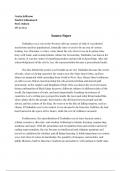Ceniya Jefferson
World Civilization II
Prof. Osborn
08/31/2023
Source Paper
Timbuktu was a city in the Western African country of Mali. It was labeled
mysterious and less popularized, ironically since it used to be an area of various
trading. Leo Africanus, a writer, wrote about the city when it was in its prime time
busy with trade, and owning Islamic culture for its learning. Timbuktu was known for
its variety. It was the center of exporting product and growth on knowledge. After the
acknowledgement of the city by Leo, the representation became a generational mark.
The idea behind the praise was brought up on why Timbuktu became the center
of trade, what was being exported, the routes near the Niger Inner Delta, and how
Islam was impacted while spreading from North to West. Also, Mansa Musa’s influence
on Africa as an African American King but who practiced Islam and shared gold
generously, to the empires and Kingdom of Mali. This was shown for several reasons
being confirmation of black kings in power, different cultures in different sides of the
world, the importance of trade, and most importantly, breaking stereotypes of
countries. Leo’s writing gave perspective inside the town and what living looked like,
what culture did to the people, their homes, the division between people and the
slaved, and the actions of the king. He went on to the idea of falling empires, such as
Ghana. If Timbuktu were to be ruined, it was deemed to be from fire. Half the city had
been burned in the space of five hours, while the rest of civilians evacuated.
Furthermore, the specialization of Timbuktu was in tran-Sararan routes,
scholar resources, diversity, and wisdom. Following to Islamic learning, engineering,
medicine and more. With the promotion and recognition from universities and never
ending representation, the city became an intellectual and religious quantum and
served as a platform for scholars and all things learning. It holds importance in various
ways, but when it comes to knowledge, the quantity of mosques, universities, and
public libraries, built to then have students go and achieve, will continue to hold value.




